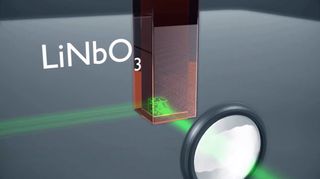Microsoft wants to use holograms to power a new generation of cloud storage
Holographic storage isn’t new technology, but Microsoft thinks implementing it in the cloud could be revolutionary.

Microsoft has revealed a new research group that hopes to solve one of the biggest challenges in cloud storage today.
Known as Project HSD (Holographic Storage Device), the group was formed in collaboration with Microsoft Research Cambridge to use holographic data storage to address the pain points of contemporary cloud storage devices, such as poor access rates and low data density.
A key advantage of holographic data storage over conventional cloud storage formats is that holograms can be erased with UV light, making holographic mediums infinitely rewriteable. Microsoft wants to take advantage of this property to use holographic storage wherever data is uploaded, modified, and deleted frequently in the cloud. The company is already working separately on using glass as a medium for archival data storage.
- These are the best cloud storage services around today
- If you're on a budget, check out these free cloud storage options
- These are the top cloud storage management services at the moment
Holographic data storage has actually been around since the 1960s, but according to Microsoft Senior Researcher Benn Thomsen, the inherent parallelism of optical storage, combined with recent advances in the field, means that storing data holographically could potentially unlock a new era of cloud innovation.
“Re-imagining [holographic storage] for the cloud, where we have the freedom to innovate across the full storage stack and bring ideas from other domains to make this a viable technology, is super exciting”, Thomsen noted.
Project HSD
So, how exactly does holographic storage work? Well, Microsoft’s technique begins by encoding a data page into a 2D image. This is then turned into a beam using a spatial light modulator, which is a device very similar to a conventional smartphone screen. After light is passed through the image it results in a data beam that, along with a reference beam, is shone onto a special salt crystal known as a Lithium niobate lattice.
The interaction between the two beams produces a unique interference pattern within the crystal, and multiple patterns can be stored within the same volume by changing the angle of the reference beam.
Are you a pro? Subscribe to our newsletter
Sign up to the TechRadar Pro newsletter to get all the top news, opinion, features and guidance your business needs to succeed!
Finally, to retrieve the stored information, the reference beam is again shone onto the lattice at the same angle. If this all sounds a bit complicated, all you really need to know is that this technique results in superb data density and makes infinite reuse of the storage medium possible.
- Our pick of the best web hosting services around
Via Engadget
Most Popular

